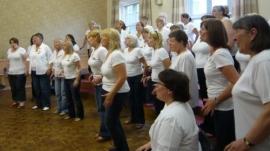Yorkshire Double
 On Sunday night I had a trip up to Yorkshire to work with the combined voices of Pennine Chimes from Bradford and Main Street Sound from York. They have been rehearsing together once a month for the last few months, as well as coordinating their plans and approaches for each group’s weekly rehearsals, and as a result are operating very much as a single ensemble. Indeed, my only clue as to who originated with which chorus were their name badges!
On Sunday night I had a trip up to Yorkshire to work with the combined voices of Pennine Chimes from Bradford and Main Street Sound from York. They have been rehearsing together once a month for the last few months, as well as coordinating their plans and approaches for each group’s weekly rehearsals, and as a result are operating very much as a single ensemble. Indeed, my only clue as to who originated with which chorus were their name badges!
During the second half of the coaching session we addressed an issue that besets so many barbershop groups: the way that introducing choreography seems to undo months of careful work on vocal production.
Sometimes you can blame the moves themselves for this – if the gestures are fighting against the way you’d want to use the body to sing well – but this wasn’t the problem here. The choreographic plan had been devised by the same team that had masterminded the plan for vocal development and was neither over-elaborate nor likely to pull the singers out of shape.
Rather, I suspected that the dip in vocal quality arose simply from extra cognitive load of having a whole extra set of actions to remember on top of the song. Accordingly, my coaching strategy was help integrate the moves into the singers’ concept of what they were doing in order that they could help rather than hinder their vocal delivery. After all, several scholars (including Ramona Wis, Therees Tkach Hibard and Chris Peterson) have shown how to use gesture as a means to enhance expressiveness and musical understanding within the rehearsal process: there’s no reason why it should not serve the same function in performance.
So we approached the issue in two stages. The first was to explore swing rhythms and the specific flavours of swing they wanted to evoke in their song (follow-through for most of it, with a brief patch of stretch-reinforce swing towards the end). Getting everybody involved in physical gestures (clicks and stretches respectively) that encapsulate each type helps develop a corporate understanding of how they are all feeling the rhythm. A click going in a different direction, or with a smaller or larger follow-through gives both visual and audible evidence of a different concept of rhythm – and you can immediately see if anyone is trying to feel the pulse on the downbeat rather than the backbeat.
This is standard stuff for coaching swing tunes, and we got the immediate improvement in synchronisation and expressive unity that a corporate concept of rhythmic character always offers. The next stage was to imbue the choreographic gestures with that same rhythmic feel. The clickiness of follow-through swing – the sense of gathering the energy just before the beat and releasing it in a shape Laban would think of as ‘flick’ (light, sudden) – needed to infuse the physical movements. And once that started to happen, the musical character of the gestures came back into the voices.
A significant part of the process was looking at the approach to a gesture. After all, as gesture theorists tell us, all gestures have a preparation, a ‘stroke’ or ‘beat’ (the bit that we read as having meaning) and a retraction. The preparation comes as you hatch and start to unfold the thought, and the stroke of the gesture arrives with or before the key word of that thought. So if a gesture is to look believable, it needs to have an origin – it needs to integrate with the thought-process of the song. And, like the stroke itself, it needs to have the rhythmic feel of the overall musical world, or it will be almost impossible to sing in a way that evokes the intended expressive effect. In this case, many of the preparations came on backbeats, and once we identified this they became a really useful way to support the musical feeling, rather than simply a functional action to get the hands in the right place.
Gestures, as David McNeill points out, are holistic and imagistic, in contrast with the analytical, sequential character of words. At the learning stage of a choreographic plan, the gestures tend to get attached to the verbal part of the brain as people build their memory maps of the performance design. But if we can re-conceptualise gesture as relating to the ‘how’ rather than the ‘what’ of performance, it can become a powerful method to enhance rather than distract from a chorus’s musical intention.
And you can tell when singers have stopped pulling themselves in multiple directions trying to remember things, because they not only make the gestures meaningful, they sing better too.
...found this helpful?
I provide this content free of charge, because I like to be helpful. If you have found it useful, you may wish to make a donation to the causes I support to say thank you.
Archive by date
- 2024 (15 posts)
- 2023 (51 posts)
- 2022 (51 posts)
- 2021 (58 posts)
- 2020 (80 posts)
- 2019 (63 posts)
- 2018 (76 posts)
- 2017 (84 posts)
- 2016 (85 posts)
- 2015 (88 posts)
- 2014 (92 posts)
- 2013 (97 posts)
- 2012 (127 posts)
- 2011 (120 posts)
- 2010 (117 posts)
- 2009 (154 posts)
- 2008 (10 posts)












